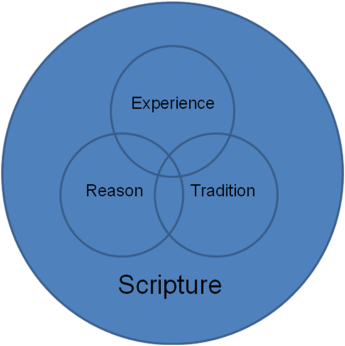
Recently I was included in a conversation about the
“Wesleyan Quadrilateral” – Scripture, Tradition,
Reason, and Experience. The phrase was coined by
Albert Outler, who later regretted that he had phrased it the way he did, as it has led to a lot of confusion. The four criteria for theological formulation have been hotly debated in Methodist circles for decades. Some have interpreted the phrase “quadrilateral” as suggesting equality among the four. The blue circular diagram included here is a representation that seems to capture the essence of the relationship among the four components to me, reason, tradition, and experience overlapping and contained within and dependent upon the authority of Scripture.
But in 2005 an Asbury Seminary professor, Dr. Paul Wesley Chilcote, offered another image that illuminates the relationship among the various aspects. He relates observing a mobile hanging over his daughter’s crib and realized that the image offered a plausible description for thinking about this dynamic concept. The top disk he called “Scripture”. Reason, Tradition, and Experience were attached to it. A student of his suggested that a wind chime is even more descriptive than a mobile.
He wrote in Good News Magazine in 2005: “In this wind chime image, Scripture, again has central place. It is the foundation, the base, the primary source and criterion for Christian doctrine and life. But Scripture itself must be balanced by the counterweight of the chimes (tradition, reason, and experience), all of which are tied directly into the biblical witness. None of these stands, as it were, independent of the Scripture or of the other norms with which each interacts. Each has its own voice that needs to sound out for music to be made….Moreover, the music of these chimes is not produced by their collision. Rather, in most wind chimes, a clapper or ball is suspended from the very center of the base..rooted as it were in the heart of Scripture…swinging back and forth among the chimes to strike the tones. This ball is, for me, the community of faith, the church, that is involved in a dynamic way with each and all of these norms related to Christian praxis. One final touch. The purpose of the wind chime is to make music. If there is no wind, then the chimes stand stagnant, purposeless, and silent. But when the wind blows..when a dynamic force sets the wind chime in motion.. then the music begins. The wind in this image is, of course, the Holy Spirit. It is the Spirit that, as the Wesleys would say, animates the whole. When the fresh wind of the Spirit blows, and the church struggles to deal with the issues, questions, and concerns of the day in this dynamic way, the consequence is a song. …The music comes nonetheless from our faithful interaction with God’s Word. “
It was my thinking about the Wesleyan Quadrilateral in 1997 and my dismay in seeing how some issues were being handled within the Methodist Church by elevating reason, experience, or tradition above Scripture as the justification for action that led me to meditate on it, write about it and discuss it with my pastor at the time.
I’ve pretty well satisfied in my own mind how to think about these four criteria for weighing truth and their relationship to doctrine. And, I think that Methodist leaders have rightly described them in the Discipline as it is today: The Scriptures are “illumined by tradition, vivified in personal experience, and confirmed by reason.”
![MPj04389070000[1]_phixr](http://disciplerofself.com/wp-content/uploads/2015/03/MPj043890700001_phixr.png)